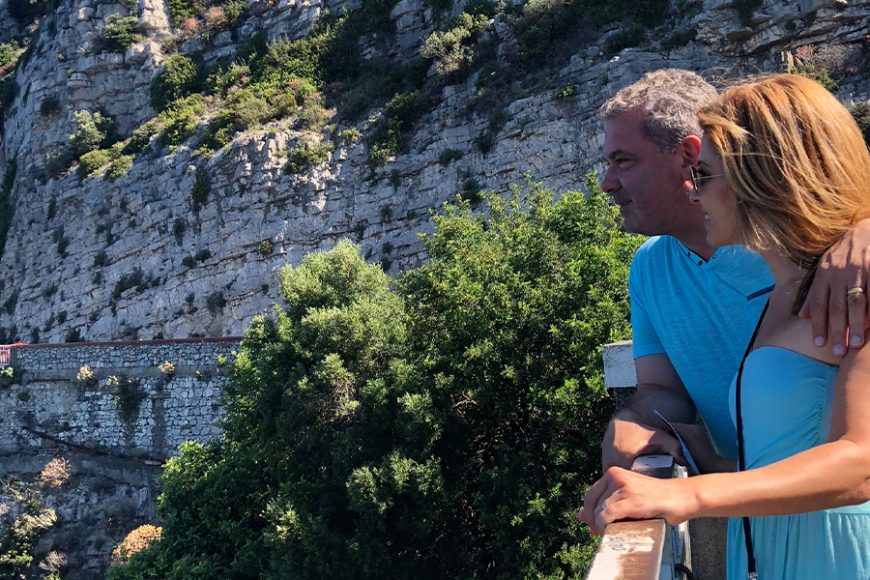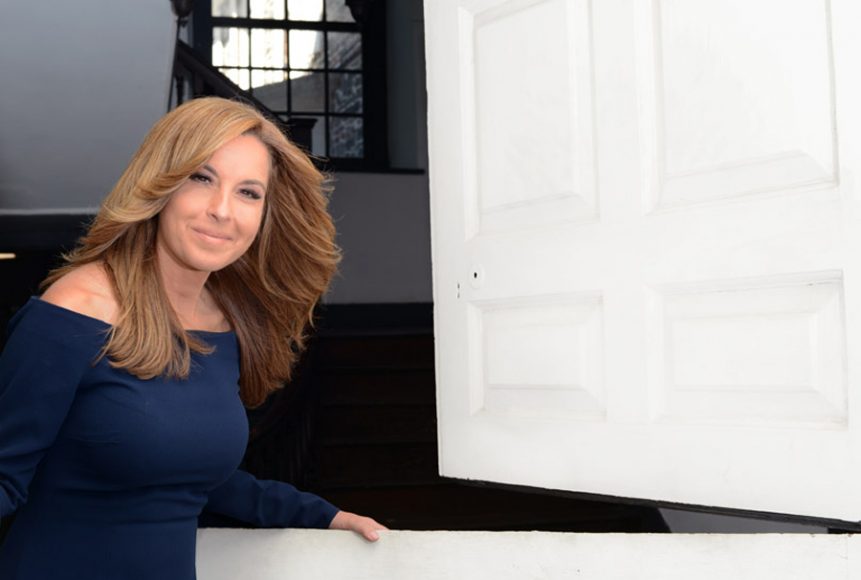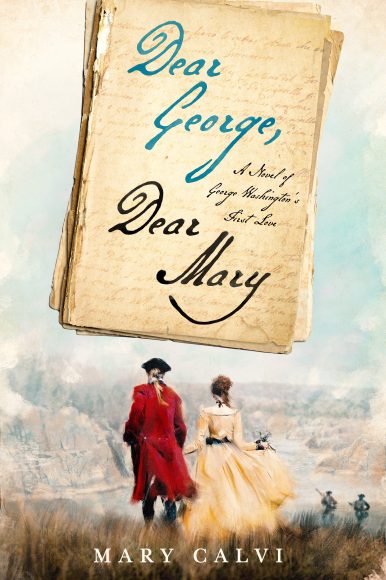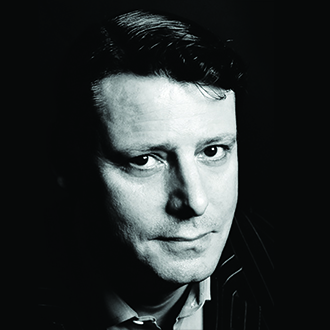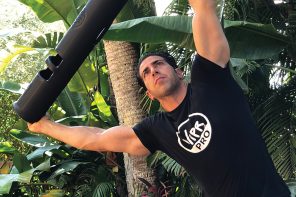When I open the door to historic Philipse Manor Hall — the 17th-century Yonkers seat of the Philipse family and Westchester County’s oldest standing building — and find Mary Calvi sitting there, ramrod straight on what could pass for an 17th- century carved oak chair, I’m struck with the notion of life imitating art. And that’s an understatement.
Calvi is the 10-time Emmy Award-winning journalist, co-anchor of “CBS2 This Morning” and “CBS2 At Noon” at WCBS-TV in Manhattan and author of “Dear George, Dear Mary” (St. Martin’s Press), a novel depicting heiress Mary Philipse’s relationship with George Washington, based on contemporary historical accounts, letters and journals. She is also, of course, the first lady of Yonkers, wife of Mayor Mike Spano. It was at her husband’s inauguration at Philipse Manor back in 2012 that Calvi saw, and was intrigued by, a portrait of her, the other Mary.
While something was known about the Philipse family — that Mary’s father, Frederick Philipse lll, who owned all the land from Spuyten Duyvil up to the Croton River and across to the Bronx river, was one of the biggest landowners in the Union at that time; that Mary herself was quite the horsewoman, regularly riding the 15 or so miles from Philipse Manor Hall to Philipsburg Manor in Sleepy Hollow — Calvi wanted to know more. “She was a Mary, I’m a Mary. I’m also a journalist. I should be able to figure this out,” she told herself.
With her imagination fired, Calvi resolved to discover the true story of Mary Philipse, and specifically her relationship with George Washington, whom Henry Cabot Lodge records fell in love with her “at short notice.” “I thought, here is a real tale to tell,” says Calvi, who looked through an archive of 26,000 documents in her quest to unravel the story. “It was like being on a treasure hunt, like putting together a puzzle.”
How Calvi has time to write a shopping list, let alone a book, is anybody’s guess. Her alarm goes off at 2:30 a.m., allowing her to get to the studio for her 4:30 to 7 a.m. slot. She is on again at noon, after which she gets “a few hours to myself.” Calvi is so hard-working, so dedicated to the cause (to TV, to journalism, to writing, to sitting on the board of the Hudson River Museum, to supporting her husband in his civic role), so utterly nice and wholesome, with genuinely not even a smidgen of an edge, that you almost have to pinch yourself to believe she is for real.
Yet real and present she most certainly is, even if, when writing her book, she chose to immerse herself in the past for the sake of her art. Working on “Dear George, Dear Mary” on her desktop at home, she drank tea from an 18th-century cup to get “in the zone” and listened to Handel, her golden retriever, Lola, by her side. “You get very caught up in the writing,” Calvi says. And having set the scene so perfectly, I had no trouble believing it.
With her friend, the caterer Josyane Colwell (of Irvington’s Le Moulin), she even re-
created a lot of the 18th-century recipes she came across, for lobster, “leaves of oyster,” Carolina snowballs (apples wrapped in rice), goose and wild boar, to experience the sort of tastes that her characters would have been accustomed to.
“An 18th-century banquet had to cover the entire table, you know,” she says conspiratorially. I did not, but I was happy to be informed.
Part historical fiction, part bodice ripper (without a bodice being actually ripped, because sadly, it is also — spoiler alert — a story of ill-fated love), it’s also part a speculation on how the entire history of the United States might have been different were it not for Mary Philipse’s brother, whose disapproval of Washington and, it transpires, his concealment of his love letters to Mary eventually scuppered the affair. Star-crossed love makes for good fiction, and “Dear George, Dear Mary” has been critically acclaimed. So we can expect more books from Calvi, who has clearly been bitten by the historical biography bug.
But was writing the book really all smooth sailing? What of the frustrations and setbacks that all writers famously feel, I ask her, eliciting a smile. “The frustration was with the words. The blank page was terrifying.” As she tells me this, she shifts uncomfortably in her chair, as if reliving the exasperation. “You see, you want to do right by them, so you have to be as accurate as possible.” And it’s true, because in Calvi’s hands, you get the feeling that George and Mary have been portrayed with great integrity, a love story, yes, but with more weight given to the history than the fiction.
When I ask the inevitable question — with a story this good, this strong, surely the movie-
makers must be clamoring to get a slice, Calvi demurs. Movie rights, refreshingly, seem not to interest her unduly. She is far keener, she explains, to promote further research into the relationship and has been talking to a national TV network about a one-
or two-part documentary spotlighting the research to date.
I’m intrigued by this altruistic approach. As Calvi has virtually “discovered” Mary Philipse, isn’t she jealous? Doesn’t she want to keep her heroine all for herself? “I’ve never thought of her as mine,” she explains. “Many people have looked at her as their own possession, but I didn’t want to do that. Other eyes should look at Mary, too.”
One of the many things I found remarkable about this book was how it captured the feeling of what it was to be alive in the mid-to-late 18th century — the privations, the cold, the heat, the dependence on craftmanship (this was pre-Industrial Revolution after all. You couldn’t just go to a store and buy a bed or a pair of riding britches). Yet for all that, there was this extraordinary sophistication. Letters could be exchanged, you could get from A to B relatively quickly, transport was not express but it was at least efficient.
As my colleague Robin Costello, who reviewed “Dear George, Dear Mary” for WAG earlier this year has noted, quite apart from the remarkable story that Calvi has unearthed, there is the extraordinary contention its historical accuracy supposes — namely, that a union between Mary Philipse and George Washington would have given Washington and the Continental Army access to Frederick Philipse’s vast wealth, thereby accelerating the events that led to our nation’s independence by at least 50 years, thus changing the history of the U.S.
It’s a fascinating premise which, were it not for Calvi, might never have been recognized or appreciated. “It may just have taken a girl from Yonkers to find a girl from Yonkers,” says Calvi, with a toss of her perfect, glossy auburn hair and a flash of her sweet and natural smile, as we walk out of Philipse Manor together. With luck she will get a few hours of rest and relaxation before that pesky 2:30 a.m. alarm goes off, and another day in her extraordinarily busy and fulfilling life begins.

